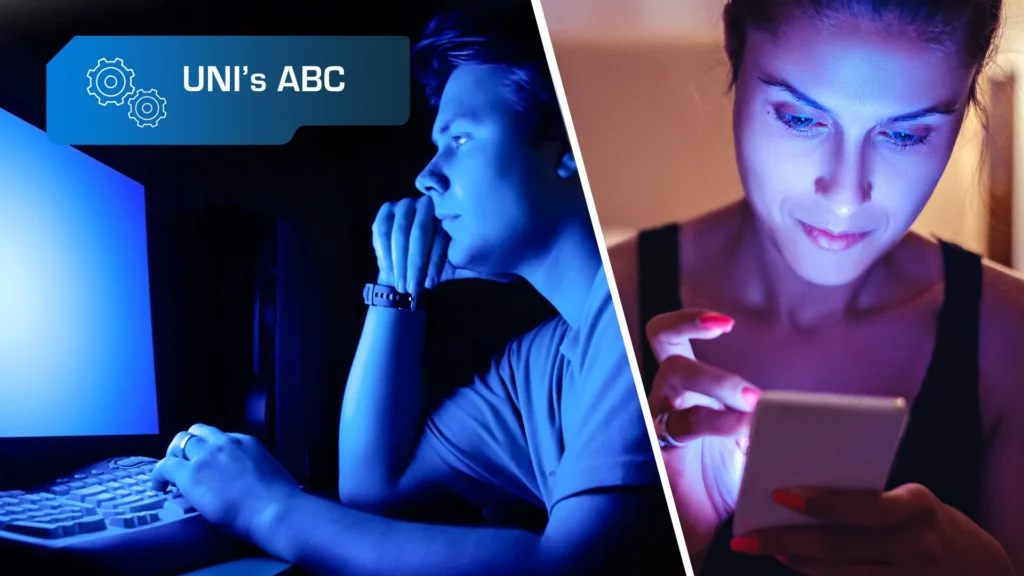
Digital devices have become an inseparable part of our daily lives. Whether we’re using a smartphone, laptop, television, or public space technology – such as self-checkout machines, ATMs, or interactive signage – they all emit what is known as blue light. Increasingly, concerns are being raised that this type of light may have a negative effect on our vision. But is there any truth to that claim? In this article, we explain what blue light is, how it affects the human body, and how to protect yourself effectively.
Table of Contents
What Is Blue Light?
Blue light is part of the visible light spectrum, with a wavelength between approximately 400 and 500 nanometers. It carries high energy and occurs in natural sunlight and artificially produced light. Nearly all modern screens emit blue light. This statement is especially true for devices that use LED backlighting, which naturally produces a high amount of blue light.
In practice, this means our eyes are regularly exposed to blue light – especially in the evening when we use screens in dimly lit environments. It’s no surprise that the topic of “blue light from screens” comes up frequently in discussions about the impact of modern technology on our health.
How Does Blue Light Affect the Eyes?
The most common concern is that blue light may damage our eyesight. But is that really the case? Research shows that prolonged exposure to intense blue light can lead to symptoms such as eye strain and even headaches – particularly when we spend long periods in front of a screen without taking breaks.
Additionally, we blink less frequently when we use screens for long periods. It leads to further drying of the eyes, resulting in redness, itch, and fatigue. It’s important to note that these effects are not caused solely by blue light. Total screen time and lack of eye-resting habits also play a significant role.
That said, evidence suggests that short-wavelength light—specifically blue light—can penetrate deeper into the eye and, over time, may potentially damage the retina. For this reason, statements such as “blue light is harmful to your eyes” or “blue light is dangerous” are not entirely unfounded, though they are often oversimplified. So, is blue light harmful? The answer is it depends. In typical, everyday exposure levels, blue light is generally not harmful. However, excessive or prolonged exposure may pose a certain risk.
Blue Light and Sleep – Is There a Connection?
One of the most frequently discussed aspects of blue light exposure is its impact on sleep. Light – especially blue light – strongly influences our biological clock, also known as the circadian rhythm. Blue light signals to the brain that it’s daytime and inhibits melatonin production, the hormone responsible for sleepiness.
If you use a smartphone, tablet, or laptop in the evening or at night, you may find it harder to fall asleep or stay asleep. This issue is particularly relevant for people with sleep disorders or those who are sensitive to disruptions in their sleep-wake cycle. In this context, the question “Does blue light affect people?” is valid because blue light can disrupt the natural rhythm of sleeping and waking, potentially affecting overall well-being.
Importantly, the problem is not the mere presence of blue light but rather the intensity and duration of exposure. That’s why many experts recommend avoiding screens for at least an hour before bedtime or using blue light filters to help maintain healthy sleep patterns.
Myths About Blue Light – What’s Exaggerated?
As with many health-related topics, a number of myths and misconceptions have developed around blue light. One of the most common claims is, “Blue light is always harmful.” That is not true. Blue light is beneficial in moderate amounts – it helps us stay alert and focused and maintain a proper circadian rhythm during the day.
Another widespread myth is that “blue light causes serious eye diseases like macular degeneration.” While some research suggests potential risks from very high, prolonged exposure, most studies are based on artificial, intensified laboratory conditions – far removed from everyday screen use.
Many experts emphasize that blue light is not harmful, or at least not to the extent often portrayed by the public. Even the question, “Is blue light bad for your eyes?” needs to be considered in context—it depends on the duration of exposure, the intensity of the light, and what protective measures are in place. Overstating the risks tends to generate unnecessary fear rather than promote helpful, preventive behavior.
How Can You Protect Your Eyes from Too Much Blue Light?
Fortunately, there are many simple and effective ways to minimize the impact of blue light—especially if you spend long hours in front of screens:
- Enable night mode. Most modern devices now include a built-in feature that reduces blue light emission in the evening (e.g., “Night Shift” or “Night Mode”). It makes the screen appear warmer and easier on the eyes.
- Use blue light filters. Special screen protectors and glasses that filter short-wavelength blue light are available. These can be particularly helpful for people who work on a computer all day.
- Take regular breaks. Follow the 20-20-20 rule: every 20 minutes, look at something 20 feet away for 20 seconds. It helps your eyes relax and reduces fatigue.
- Optimize your workspace lighting – Balanced and properly positioned lighting reduces screen contrast and helps relieve visual strain.
- Adjust screen brightness – In darker environments, lower the brightness of your monitor and use indirect ambient lighting to reduce stress on the eyes.
The effects of blue light can be significantly reduced through the conscious use of digital devices and a few simple lifestyle adjustments. While headlines may alarmingly claim that “blue light harms your eyes,” the reality is much more nuanced. The key factor is not the existence of blue light but how much, how often, and under what conditions we are exposed to it.